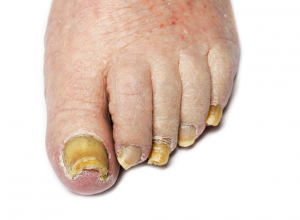
Yellow Nail Syndrome
Yellow nail syndrome, also known as “primary lymphedema associated with yellow nails and pleural effusion,” is an extremely rare disease characterized by discoloration and malformation of the fingernails and/or toenails. It can also affect the respiratory tract and cause swelling in the body due to accumulation of lymph fluid under the skin.
Symptoms
The most noticeable sign of yellow nail syndrome is a thickening and yellowing (sometimes yellow-green) of the nails in conjunction with slowed nail growth, separation of the nails from the nail bed (onycholysis), and hardened or infected skin around the cuticles. Both toenails and fingernails can be affected.
Other signs of yellow nail syndrome include accumulation of fluid in the lungs and chest cavity (which can cause coughing and shortness of breath), inflammation of the bronchial tubes and inflammation of the nasal passages. These symptoms can then lead to bronchitis, sinusitis and recurrent pneumonia. About 40 percent of people with yellow nail syndrome will develop bronchiectasis. In fact, many people who develop yellow nail syndrome already have a history of respiratory problems.
Some people who have yellow nail syndrome also experience swelling of the arms and legs. This is caused by an accumulation of fluid known as lymph forming under the skin. This can cause decreased range of motion and flexibility in the feet, ankles, hands and wrists as well as a hardening of the skin in the extremities.
Causes
Experts disagree on what exactly causes yellow nail syndrome. Some believe it is completely random, some believe it’s due to titanium ingestion, and other medical professional believe the condition is genetic, meaning it runs in families. Limited research suggests yellow nail syndrome I slinked to mutations of the FOXC2 gene, which can cause a similar disorder called lymphedema-distichiasis syndrome.
People who have certain types of cancer, arthritis and immunodeficiency syndromes seem to be at a higher risk of developing yellow nail syndrome. Some doctors believe thiol drugs (drugs which are sometimes used to treat rheumatoid arthritis) have been linked to the development of the disease.
Treatment
Yellow nail syndrome is rare, having affected only a few hundred people that health care providers know of. Therefore, treatment depends on each individual and their specific symptoms. Some options may include antibiotics for the respiratory problems and corticosteroids. Oral clarithromycin and Vitamin E are also usually recommended for the nail discoloration.
Notice concerning medical entries:
Articles having medical content shall serve exclusively for the purpose of general information. Such articles are not suitable for any (self-) diagnosis and treatment of individual illnesses and medical indications. In particular, they cannot substitute for the examination, advice, or treatment by a licensed physician or pharmacist. No replies to any individual questions shall be effected through the articles.







